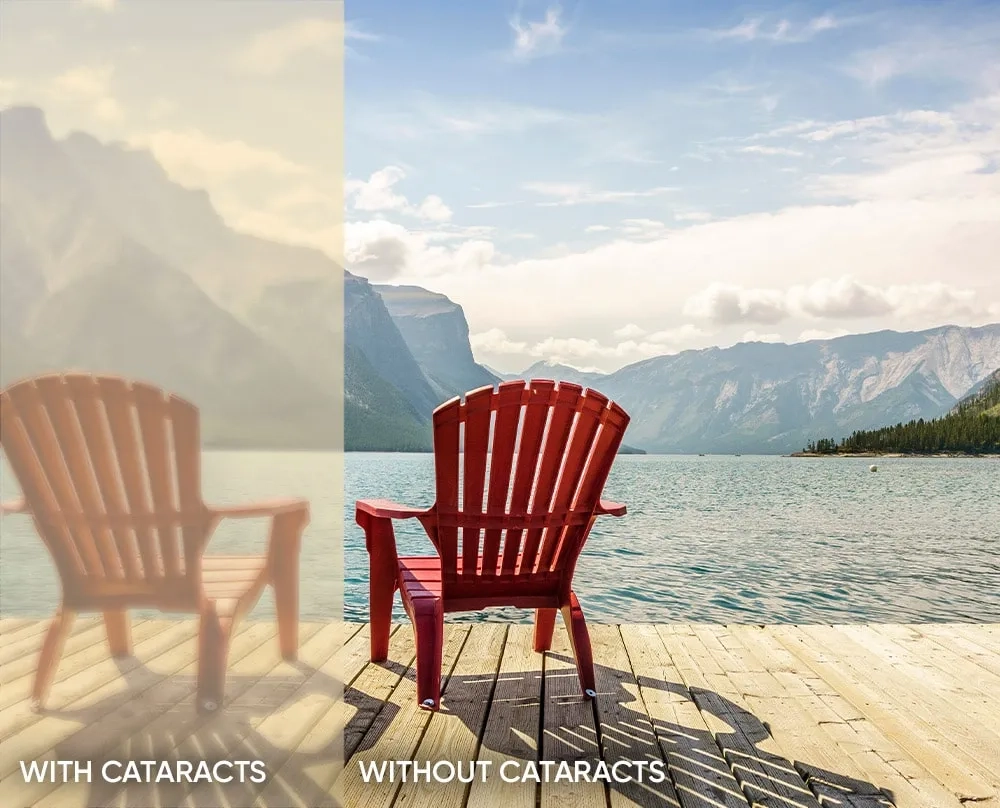What is a cataract?
Most cataracts are age-related, this is why cataracts are most common in older people.
By age 80, more than half of all North Americans have had a cataract or have undergone cataract surgery.

The lens of the eye is naturally clear, it can become cloudy over time. As this occurs, it restricts the amount of light that’s able to pass through the eye, thereby hindering vision.
Though you may not notice cataract symptoms at first, as your vision begins to deteriorate with age, it will only get worse with time.
What causes cataracts?
There are two ways age-related cataracts develop:
Protein clusters reduce sharpness of the image.
The eye’s lens consists mainly of water and proteins, but when the protein clumps together over time, it clouds the lens and restricts the light reaching the retina. The protein clump grows larger in size with time, gradually reducing the quality of vision by making things duller and blurrier.
The lens discolours, leaving a brownish tint.
Although the eye’s lens is naturally clear, it can develop a brownish shade with age. Tinting is usually not noticeable at first. However, over time, it may make everyday activities more difficult to accomplish. For example, with advanced lens discoloration, you may have difficulty identifying blues and purples.
What are the symptoms of cataracts?
The most common symptoms of a cataract are:
- Poor night vision
- Colours seem faded
- Glare or a halo around lights
- Double vision or multiple images in one eye
- Cloudy or blurry vision (often described as 'milky' or 'hazy')
- Frequent prescription changes in your eyeglasses or contact lenses
These symptoms can also be a sign of other eye problems. If you experience any of the aforementioned symptoms, be sure to speak with your optometrist.
What are the risk factors for cataracts?
Cataracts eventually affect everyone. The typical onset happens between 60 and 70 years of age. However, earlier or later onsets are not uncommon. While the risk of cataracts increases with age, there are other factors that can influence the speed and severity of cataracts. Other risk factors for cataracts include:
- History of eye injury
- Certain diseases (ie. diabetes)
- Lifestyle choices (smoking or alcohol use)
- Environment (prolonged exposure to ultraviolet sunlight)
Are cataracts reversible?
No. Unfortunately, there is no medication available to cure or reverse cataracts. Glasses and contact lenses offer a short-term solution, and can temporarily allow you to complete regular activities, like reading or driving. However, your cataracts will only get progressively worse over time. Glasses and contacts may not always be enough to improve your vision. For this reason, we recommend a prompt cataract lens replacement. Since cataracts become gradually worse with age and if left untreated, a lens replacement is the only way to prevent further damage and improve visual clarity.

How are cataracts treated?
An intraocular lens surgery or a cataract surgery is the only long-term solution to cataracts. It works by replacing the lens that’s affected by the cataract with a new, implanted intraocular lens (IOL). Intraocular lens surgery is a very common and safe elective medical procedure.
Over 50 million cataract surgeries have been performed worldwide.
At TLC Laser Eye Centres, we’re proud to offer a wide variety of intraocular lens procedures:
Refractive Cataract Surgery (RCS)
Refractive Lens Exchange (RLE)
Laser-Assisted Intraocular Surgery
Implantable Collamer® Lens (ICL)
In addition, we also offer a wide selection of replacement lenses that can also treat refractive errors in addition to cataracts, including myopia (nearsightedness), hyperopia (farsightedness), astigmatism, and presbyopia.
Discover if you're a candidate!
At your pre-operative consultation, our experts will evaluate your specific needs and desired outcome and will recommend a procedure to you accordingly. They will explain the details of the procedure, why it’s the best option for your situation, and what you can expect.